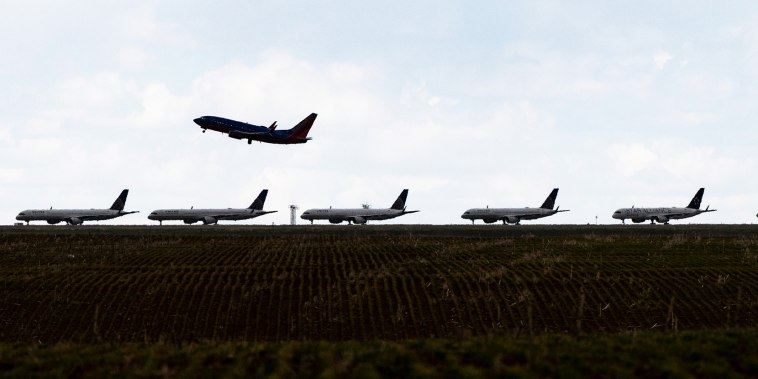March 11, 2024
Rising Frequency of Aviation Incidents: Why Experts Say There’s No Cause for Concern
 Aviation incidents, whether minor mishaps or major accidents, have been a topic of concern and scrutiny for decades. The aviation industry is one that is highly regulated and constantly evolving to ensure the safety of passengers and crew members. Despite recent reports of incidents, experts in the field maintain that there is no reason for alarm and that flying remains one of the safest modes of transportation.
One crucial aspect that experts emphasize is the continuous improvement in aircraft technology and safety measures. Aircraft manufacturers invest heavily in research and development to design airplanes that are not only more efficient but also safer. Modern aircraft are equipped with advanced systems that are capable of detecting and mitigating potential risks, such as mechanical failures or adverse weather conditions. These technological advancements have significantly reduced the likelihood of accidents due to technical failure.
Furthermore, the aviation industry places a strong emphasis on training and certification for both pilots and maintenance crews. Pilots undergo rigorous training programs that include simulations of various emergency scenarios to ensure they are well-equipped to handle unexpected situations. Maintenance crews are also required to adhere to strict protocols and safety standards to maintain aircraft in optimal condition. These measures are designed to prevent incidents caused by human error or inadequate maintenance.
In addition to the technological and training aspects, the aviation industry also benefits from a robust regulatory framework that governs air travel worldwide. International aviation organizations, such as the International Civil Aviation Organization (ICAO) and the Federal Aviation Administration (FAA), establish standards and regulations to ensure uniform safety practices across the globe. These regulations are continuously updated and improved to address emerging risks and technological advancements in the industry.
Despite these reassurances, incidents do occur in aviation, ranging from minor incidents such as bird strikes to more serious accidents like runway overruns. However, experts argue that these incidents should be viewed in the context of the millions of flights that take place each year without any issues. Statistically, flying remains one of the safest modes of transportation, with the chances of being involved in a plane crash being extremely low.
It is important for the public to trust in the expertise and dedication of aviation professionals who work tirelessly to ensure the safety of air travel. While incidents may grab headlines and prompt concerns, it is essential to recognize the industry's strong safety record and ongoing efforts to further enhance aviation safety. By maintaining a proactive approach to safety and embracing technological advancements, the aviation industry can continue to prioritize the well-being of passengers and crew members, further solidifying its position as a safe and reliable mode of transportation.
Aviation incidents, whether minor mishaps or major accidents, have been a topic of concern and scrutiny for decades. The aviation industry is one that is highly regulated and constantly evolving to ensure the safety of passengers and crew members. Despite recent reports of incidents, experts in the field maintain that there is no reason for alarm and that flying remains one of the safest modes of transportation.
One crucial aspect that experts emphasize is the continuous improvement in aircraft technology and safety measures. Aircraft manufacturers invest heavily in research and development to design airplanes that are not only more efficient but also safer. Modern aircraft are equipped with advanced systems that are capable of detecting and mitigating potential risks, such as mechanical failures or adverse weather conditions. These technological advancements have significantly reduced the likelihood of accidents due to technical failure.
Furthermore, the aviation industry places a strong emphasis on training and certification for both pilots and maintenance crews. Pilots undergo rigorous training programs that include simulations of various emergency scenarios to ensure they are well-equipped to handle unexpected situations. Maintenance crews are also required to adhere to strict protocols and safety standards to maintain aircraft in optimal condition. These measures are designed to prevent incidents caused by human error or inadequate maintenance.
In addition to the technological and training aspects, the aviation industry also benefits from a robust regulatory framework that governs air travel worldwide. International aviation organizations, such as the International Civil Aviation Organization (ICAO) and the Federal Aviation Administration (FAA), establish standards and regulations to ensure uniform safety practices across the globe. These regulations are continuously updated and improved to address emerging risks and technological advancements in the industry.
Despite these reassurances, incidents do occur in aviation, ranging from minor incidents such as bird strikes to more serious accidents like runway overruns. However, experts argue that these incidents should be viewed in the context of the millions of flights that take place each year without any issues. Statistically, flying remains one of the safest modes of transportation, with the chances of being involved in a plane crash being extremely low.
It is important for the public to trust in the expertise and dedication of aviation professionals who work tirelessly to ensure the safety of air travel. While incidents may grab headlines and prompt concerns, it is essential to recognize the industry's strong safety record and ongoing efforts to further enhance aviation safety. By maintaining a proactive approach to safety and embracing technological advancements, the aviation industry can continue to prioritize the well-being of passengers and crew members, further solidifying its position as a safe and reliable mode of transportation.
If you would like to delve into the world of investment topics , go to our partner project Wall Street Wizardry


